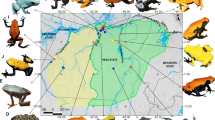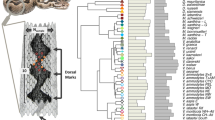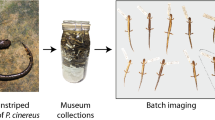Abstract
DIVER1 has shown that polymorphism in colour and pattern in living populations of the land snail, Cepaea, may also be distinguished in Pleistocene fossils, and although there may have been changes in the relative frequency of the colour forms, the polymorphism has persisted for thousands of years.
This is a preview of subscription content, access via your institution
Access options
Subscribe to this journal
Receive 51 print issues and online access
$199.00 per year
only $3.90 per issue
Buy this article
- Purchase on Springer Link
- Instant access to full article PDF
Prices may be subject to local taxes which are calculated during checkout
Similar content being viewed by others
References
Diver, C., Nature, 124, 183 (1929).
Bishop, W. W., Proc. Fourth Pan African Cong. Prehist., Leopoldville, 1959, 245 (1962).
Owen, D. F., Nature, 198, 201 (1963).
Author information
Authors and Affiliations
Rights and permissions
About this article
Cite this article
OWEN, D. Polymorphism in Living and Pleistocene Populations of the African Land Snail, Limicolaria martensiana. Nature 199, 713–714 (1963). https://doi.org/10.1038/199713b0
Issue Date:
DOI: https://doi.org/10.1038/199713b0
This article is cited by
-
Polymorphism in West African snails
Heredity (1968)
Comments
By submitting a comment you agree to abide by our Terms and Community Guidelines. If you find something abusive or that does not comply with our terms or guidelines please flag it as inappropriate.



